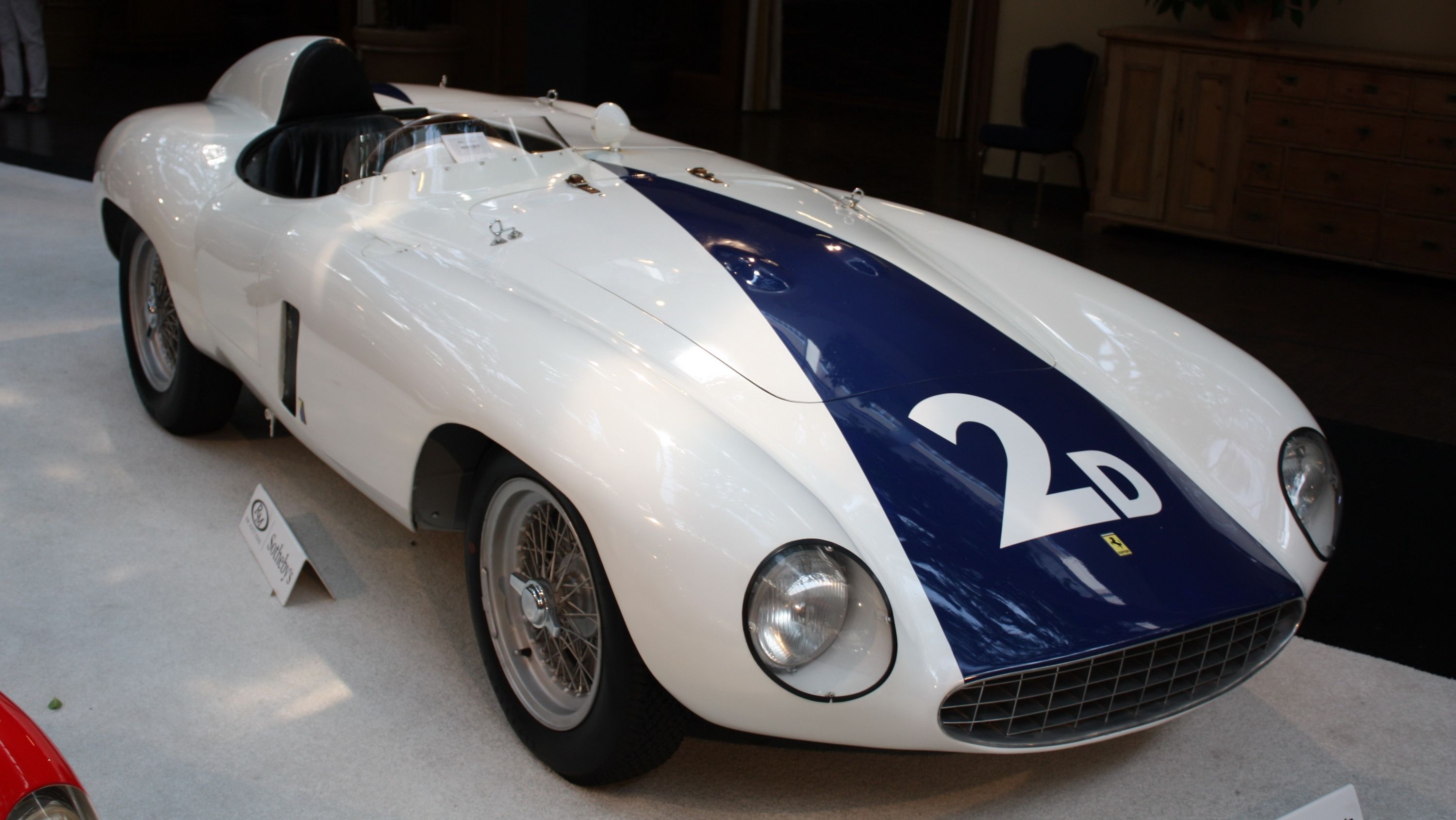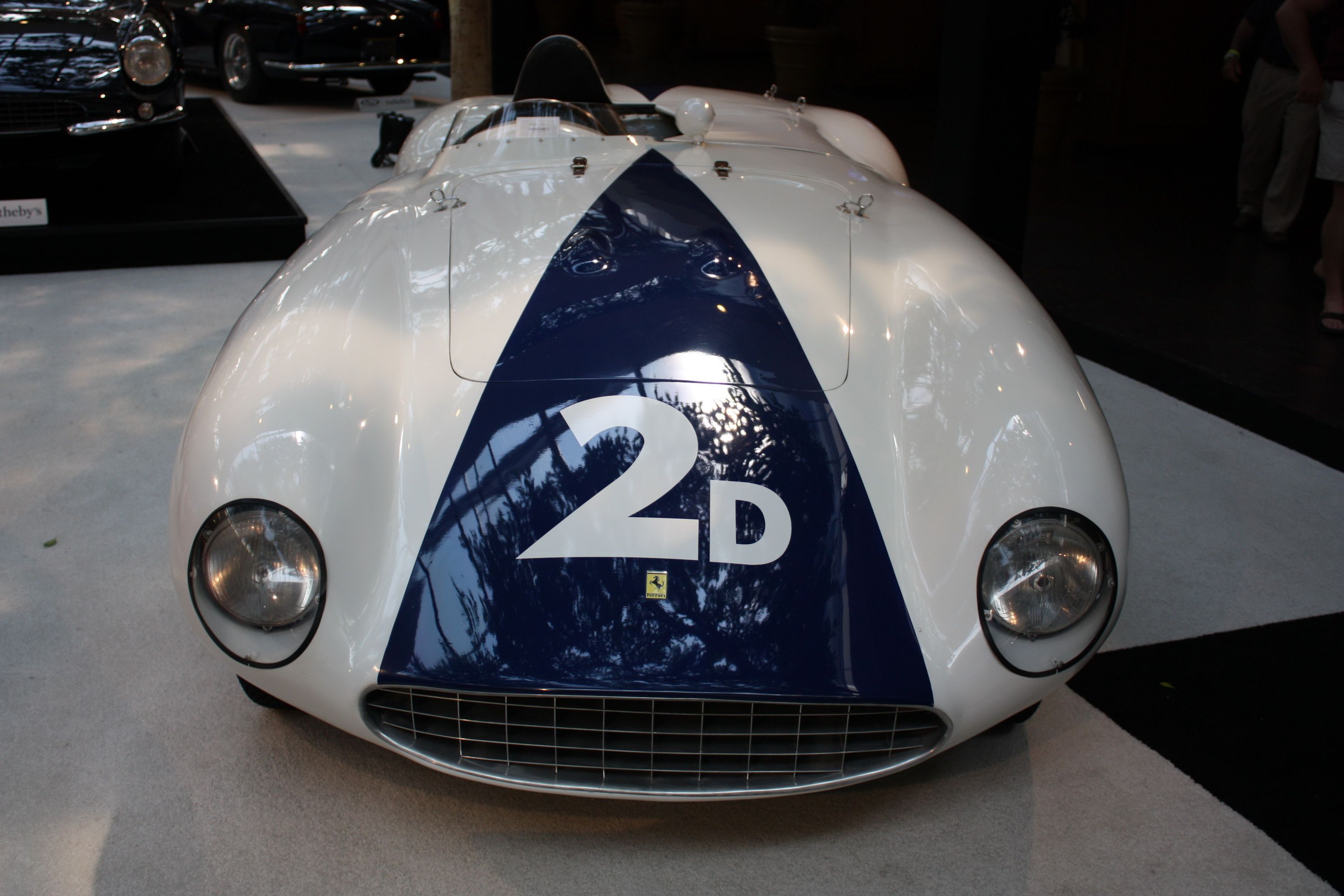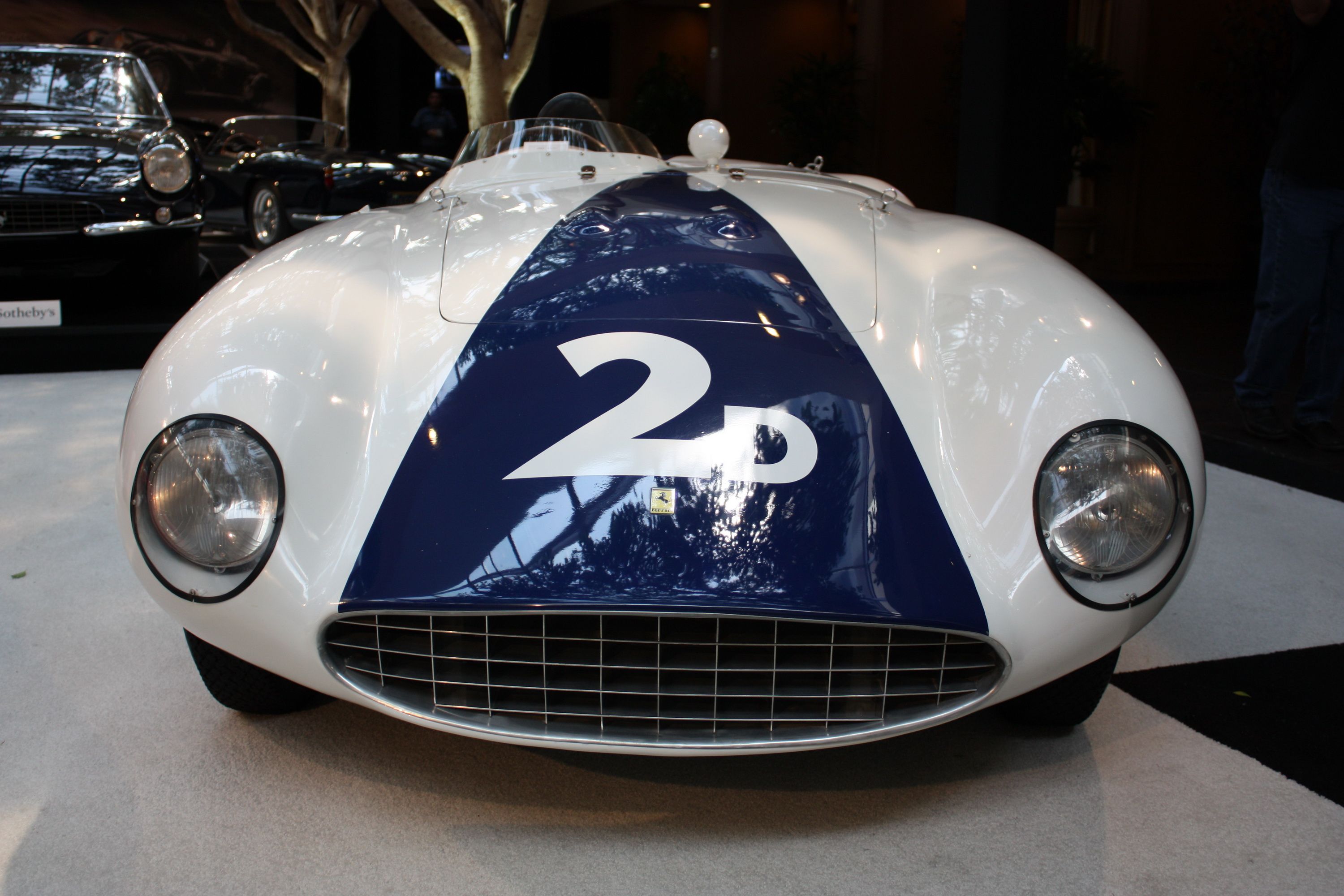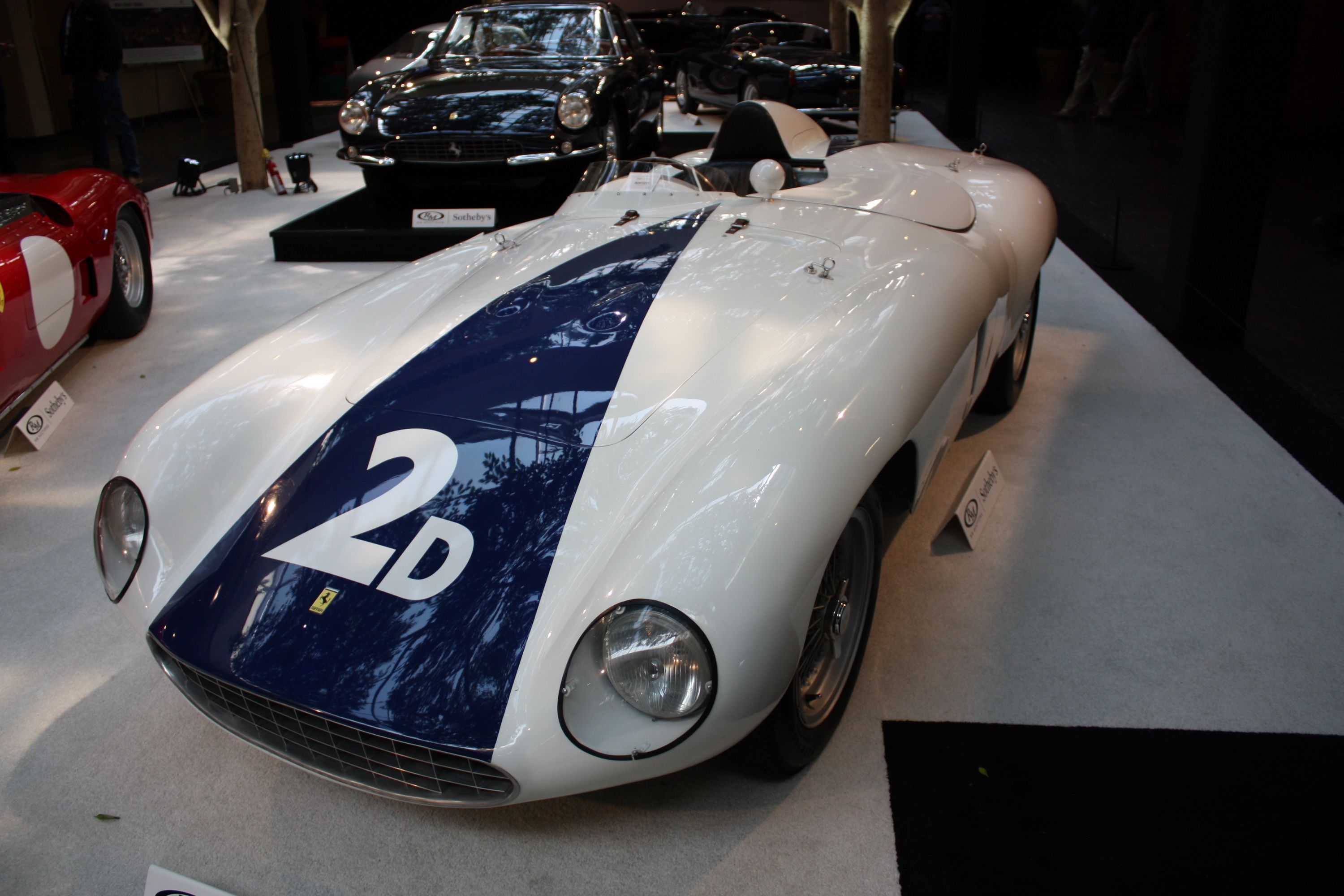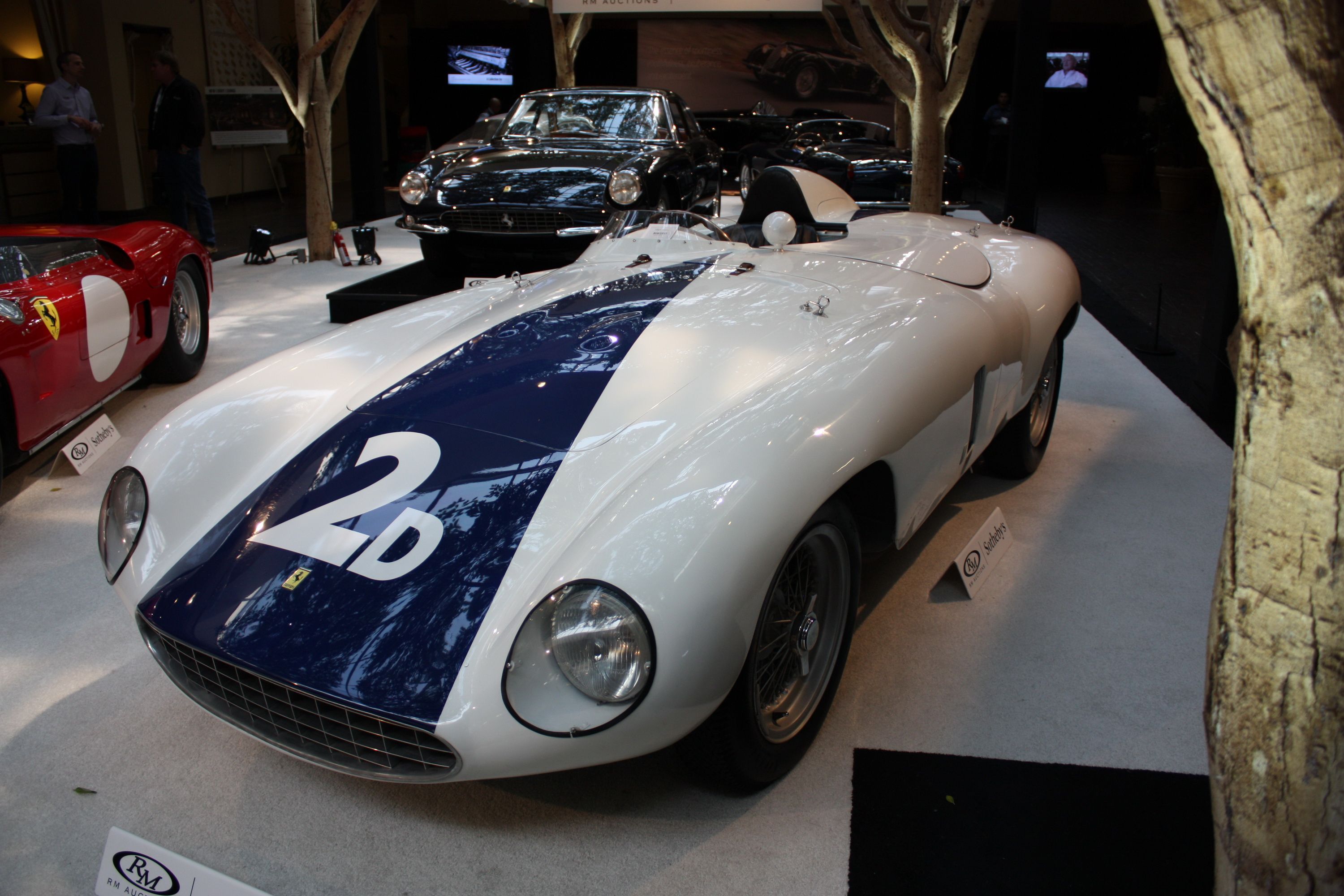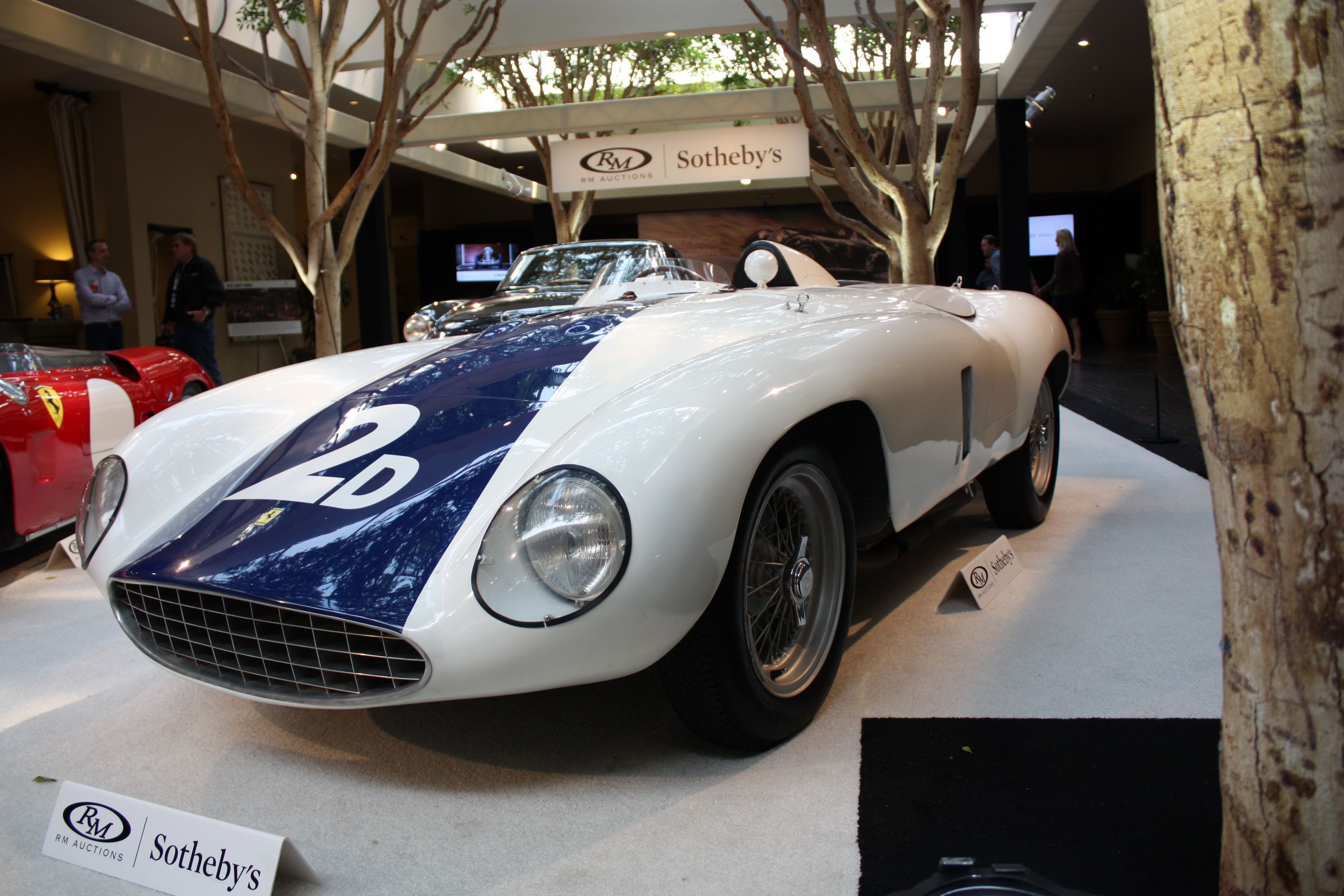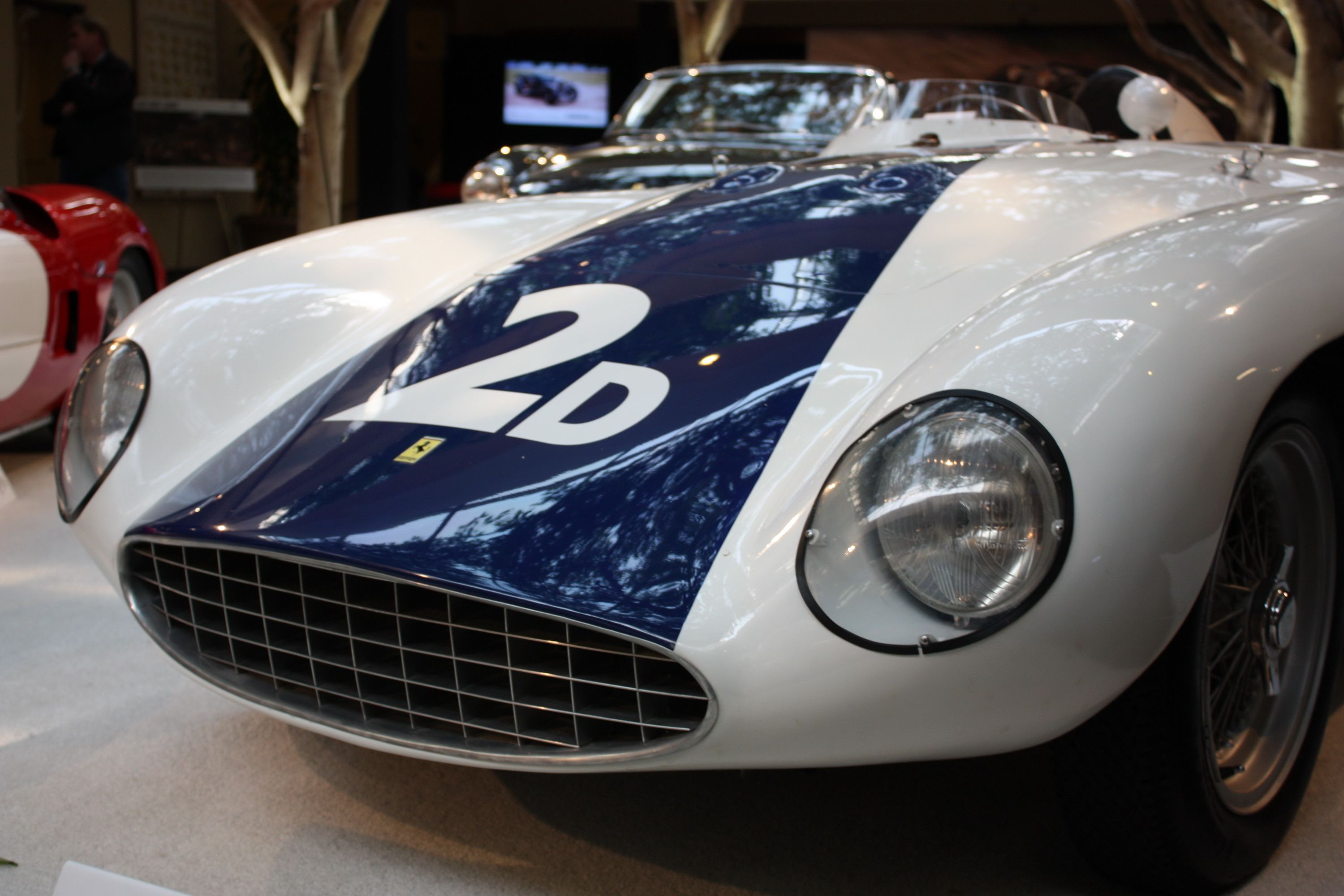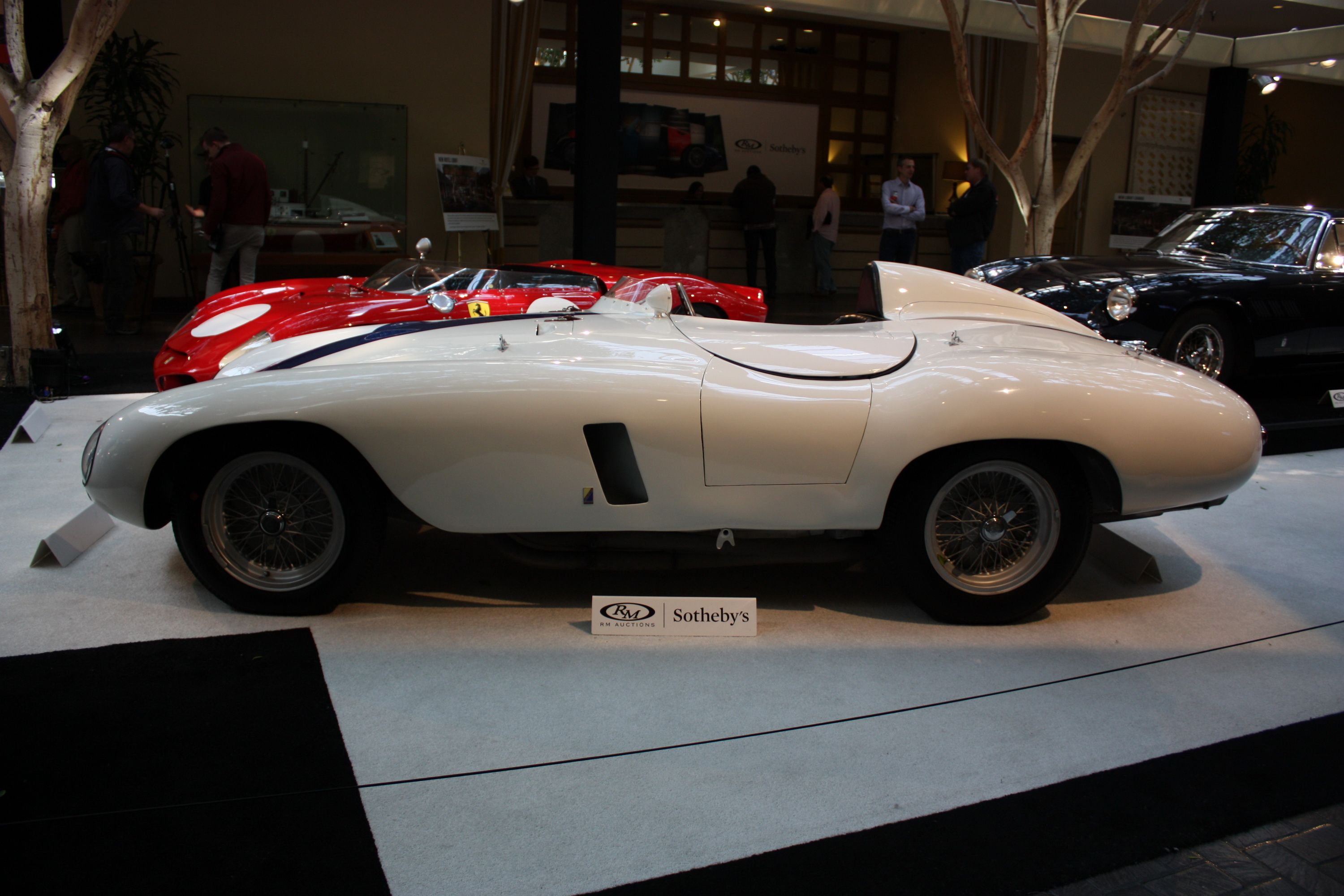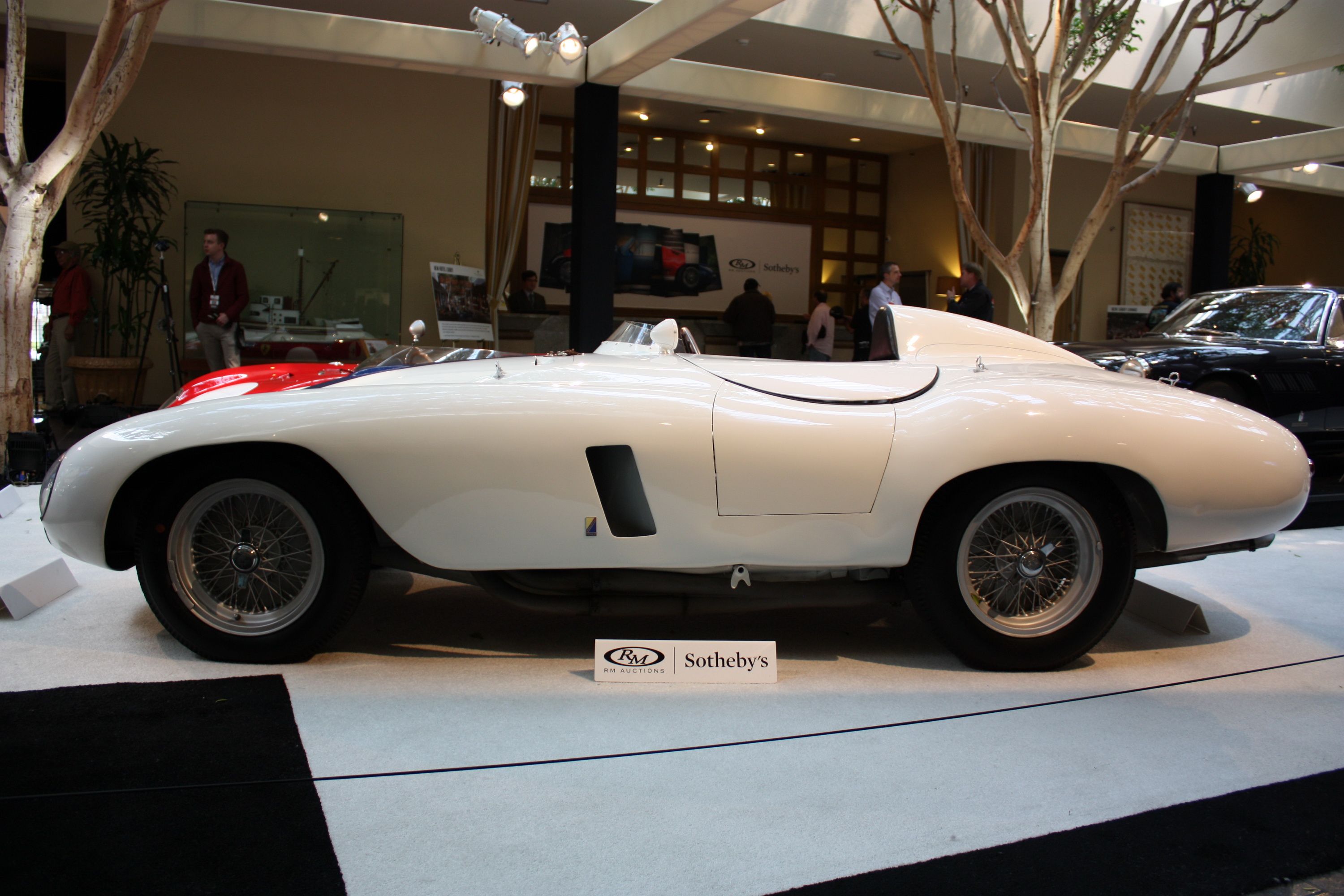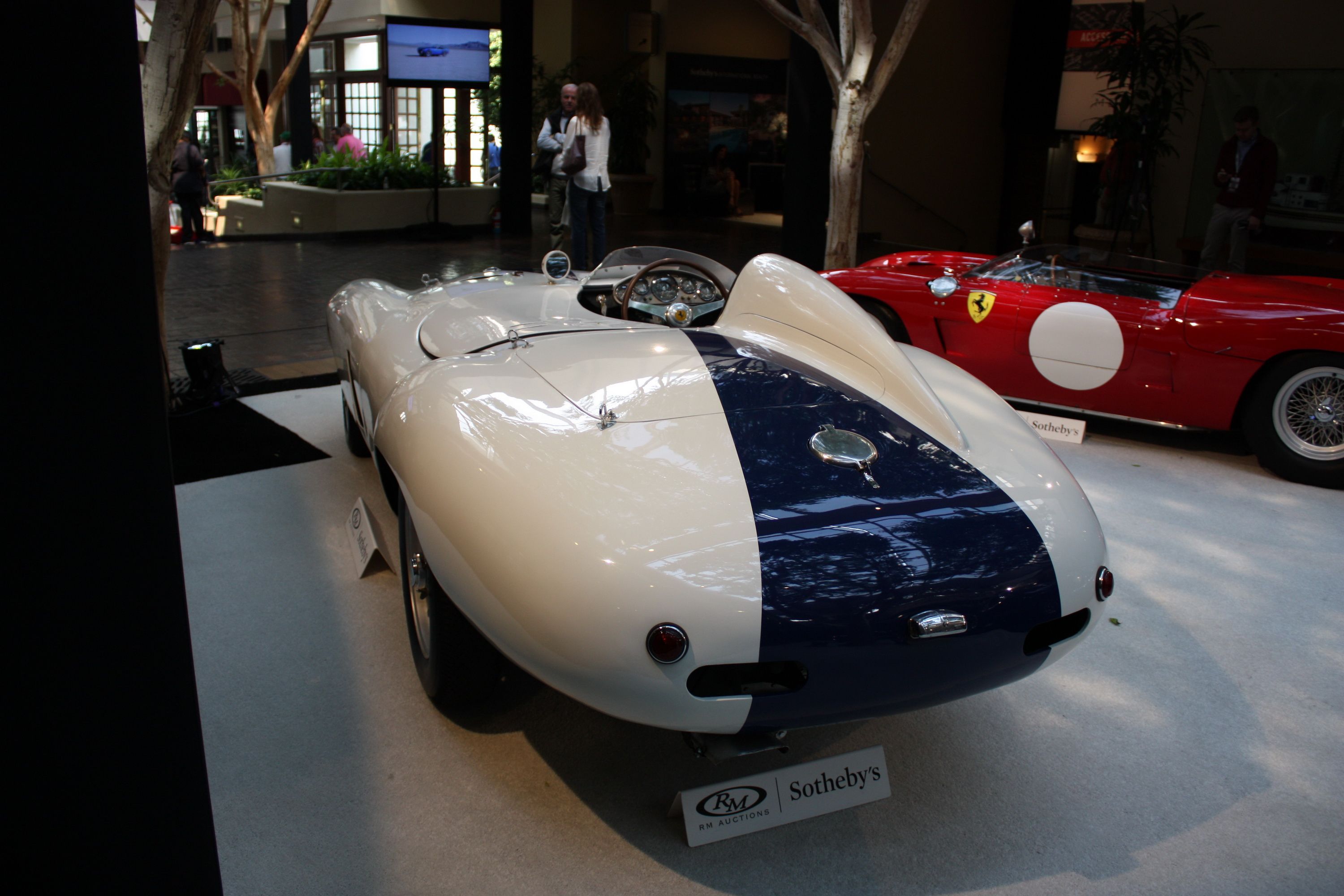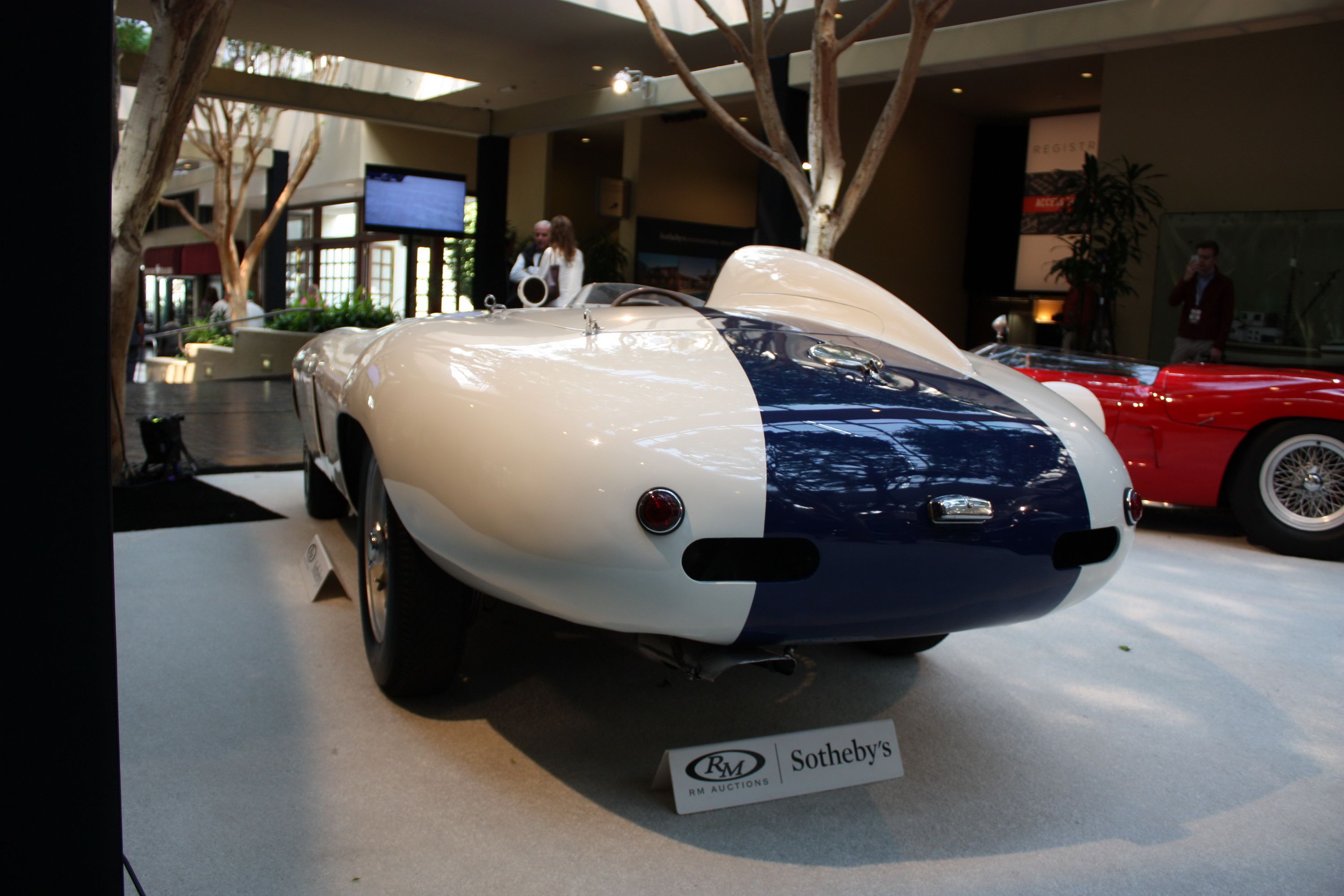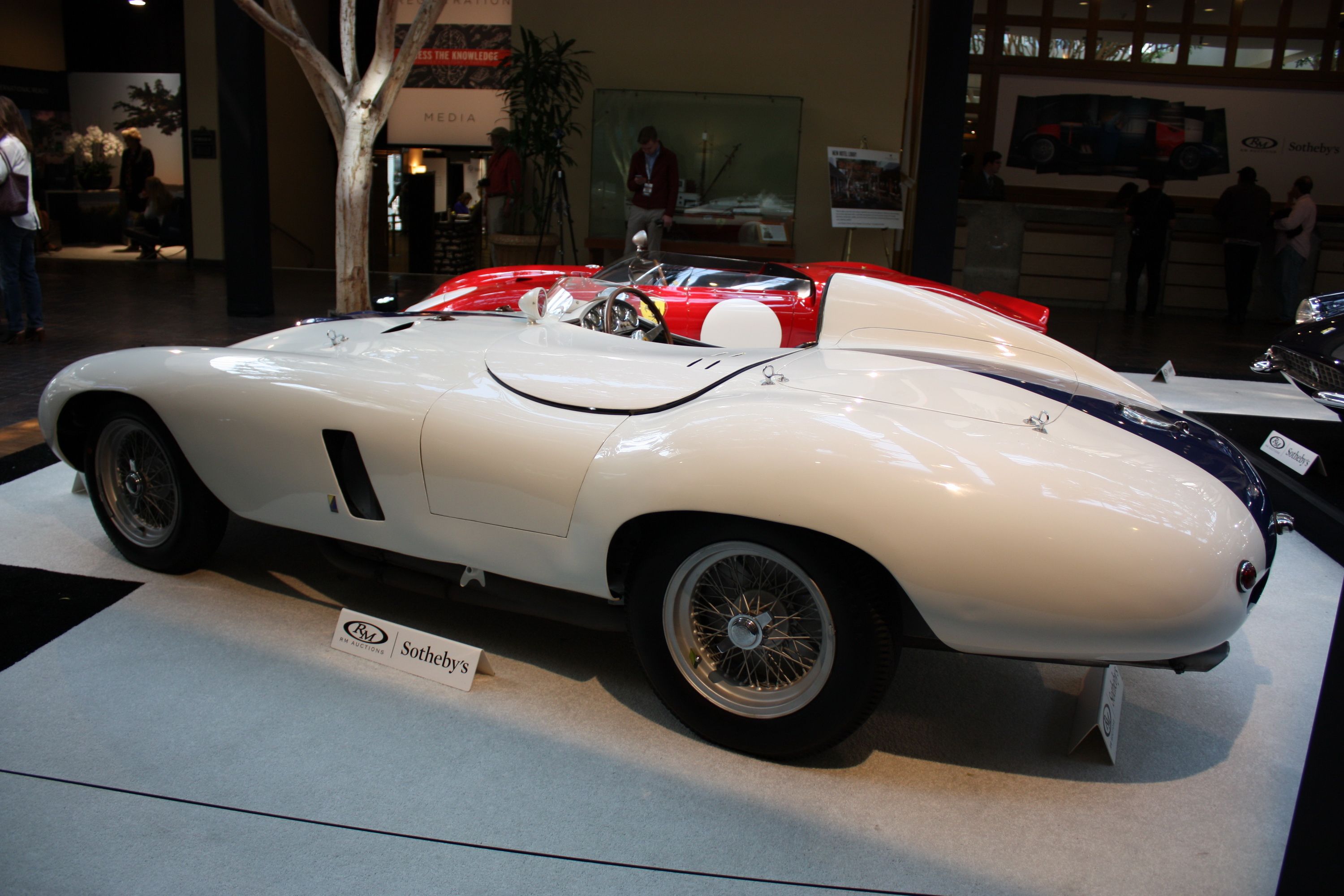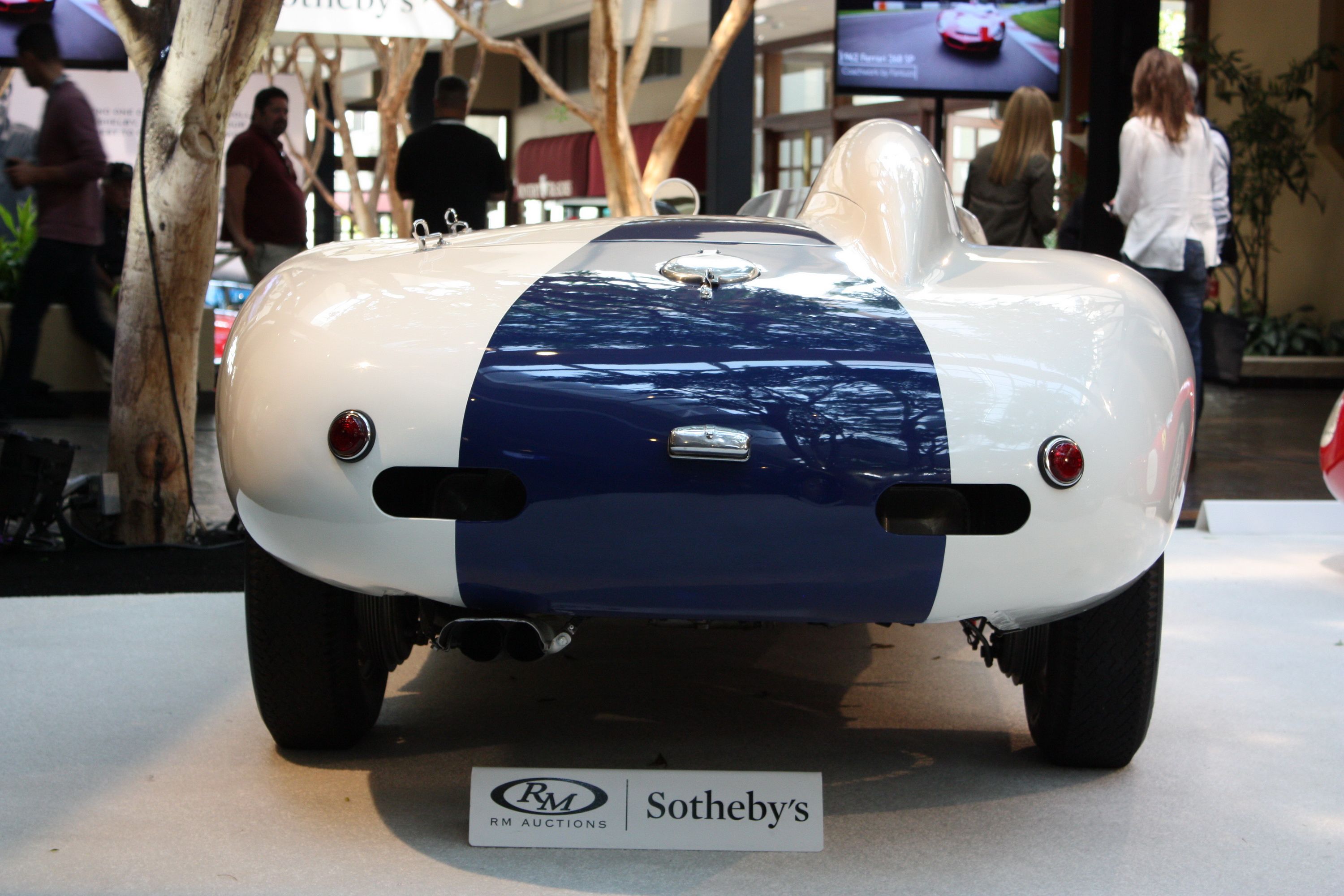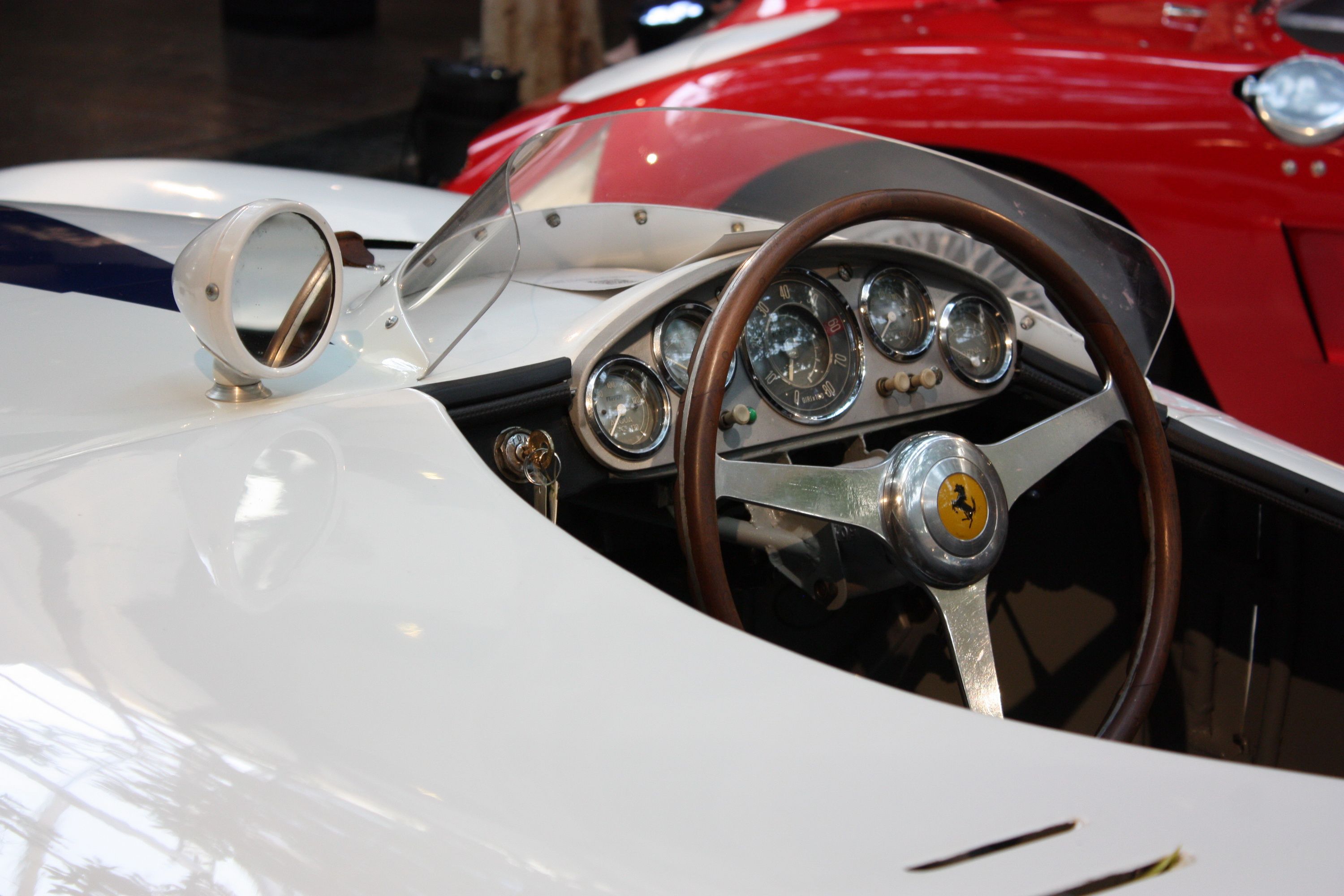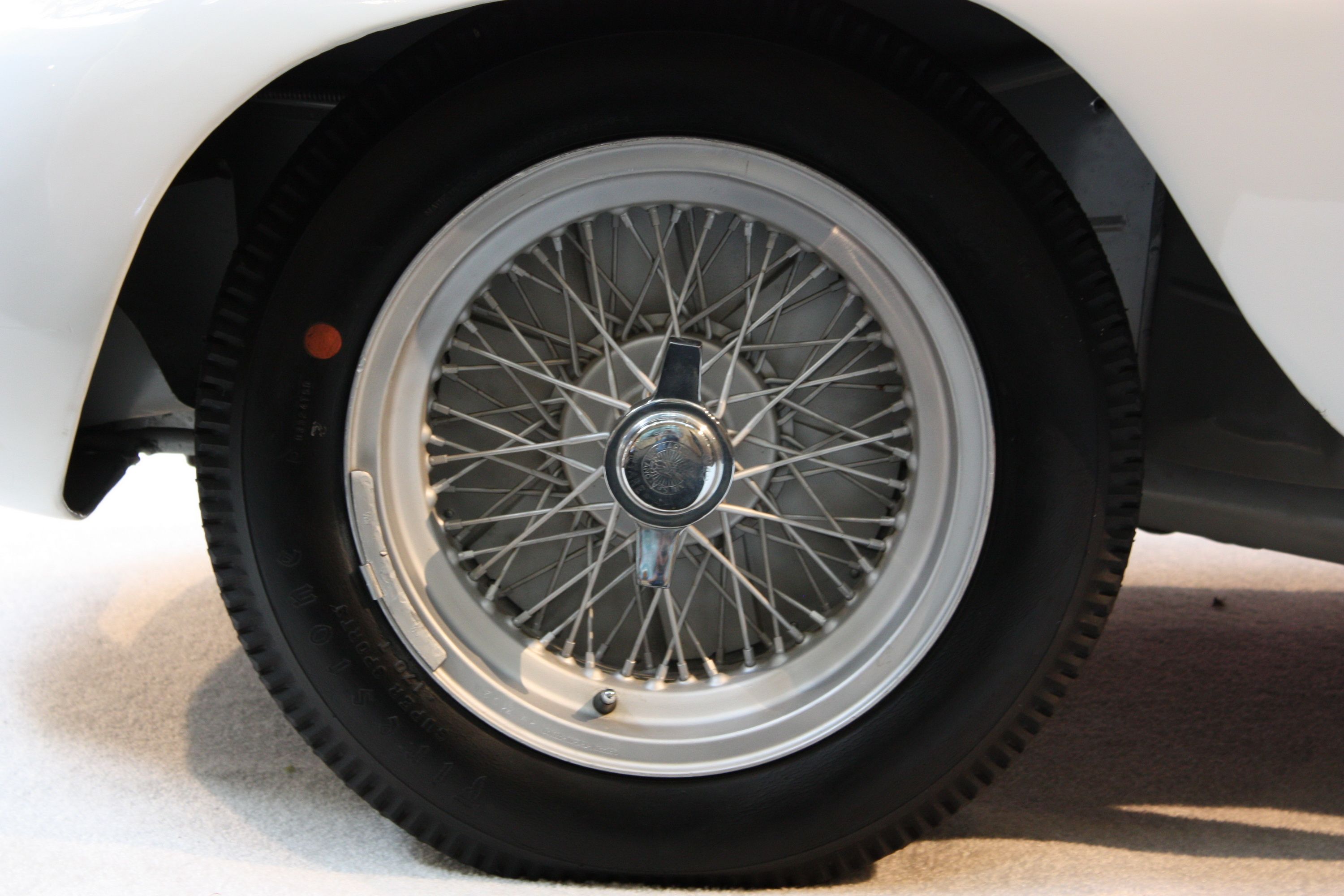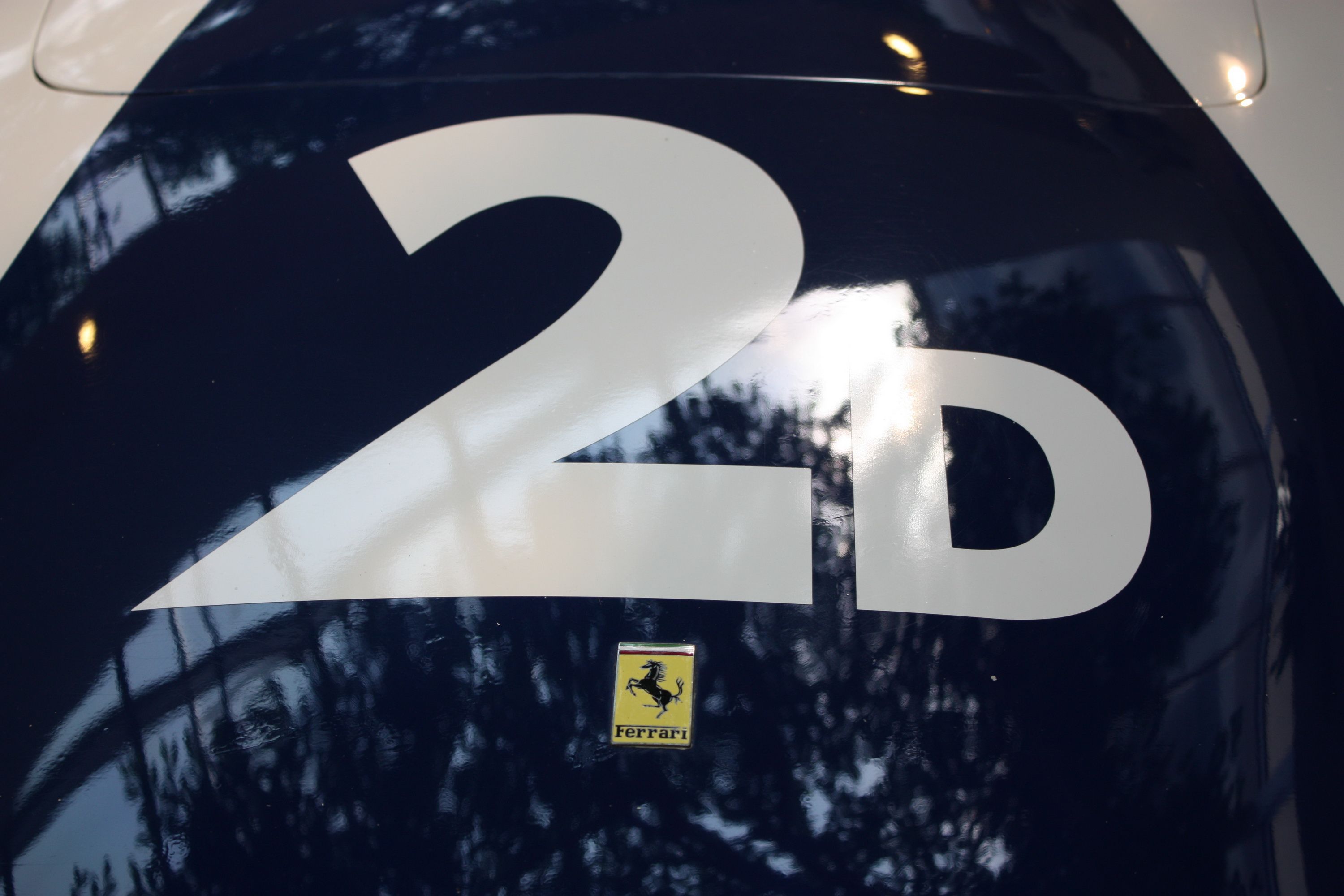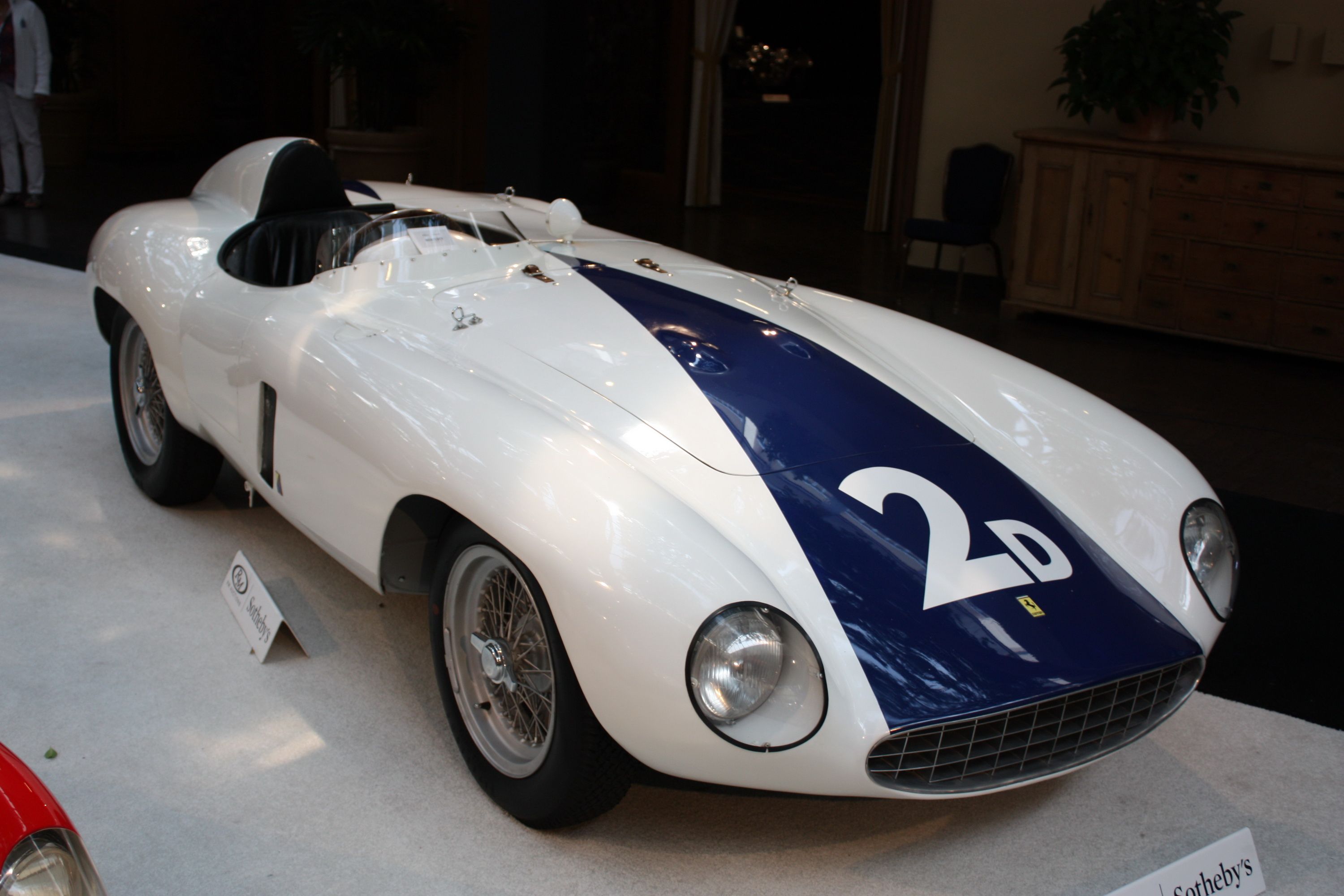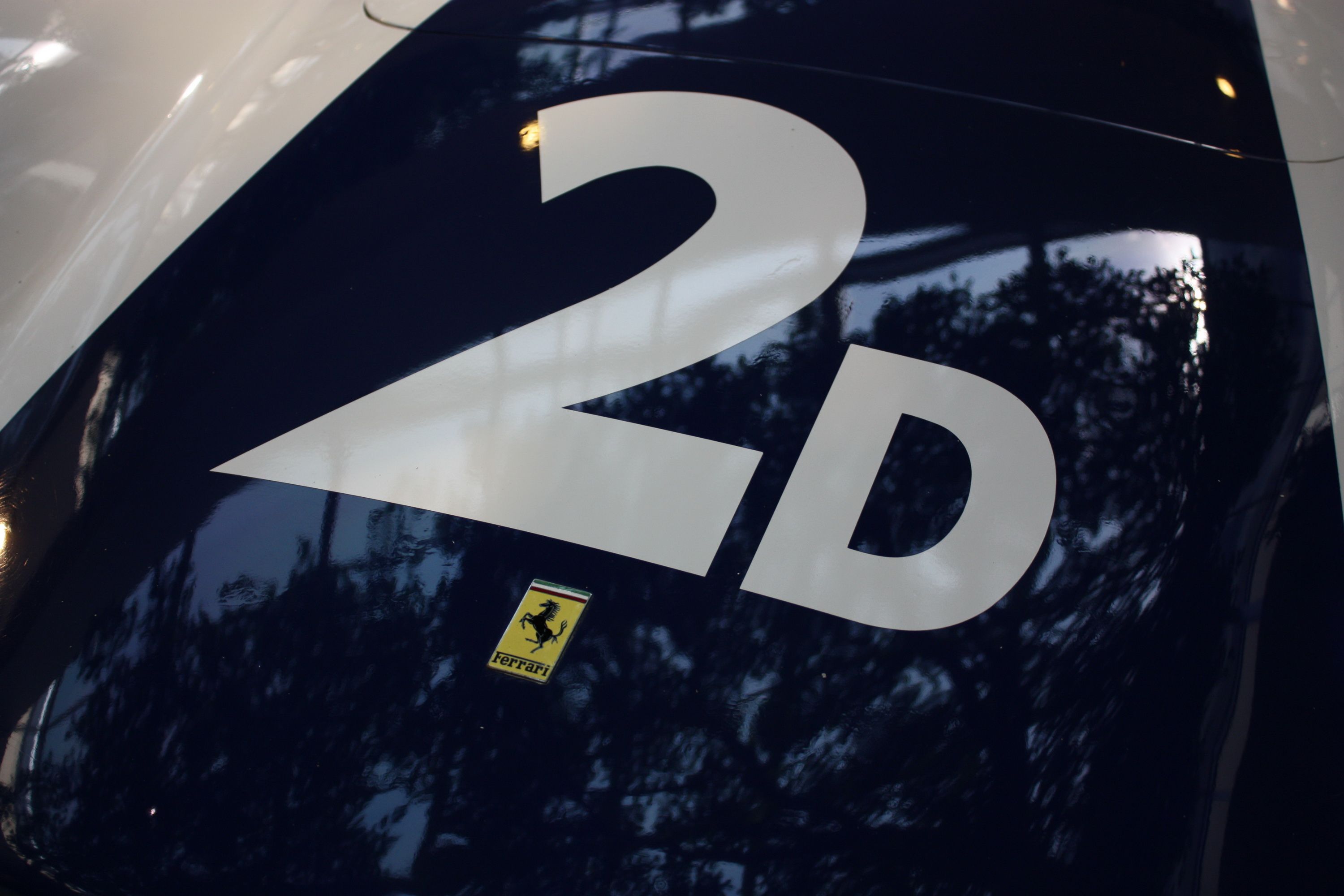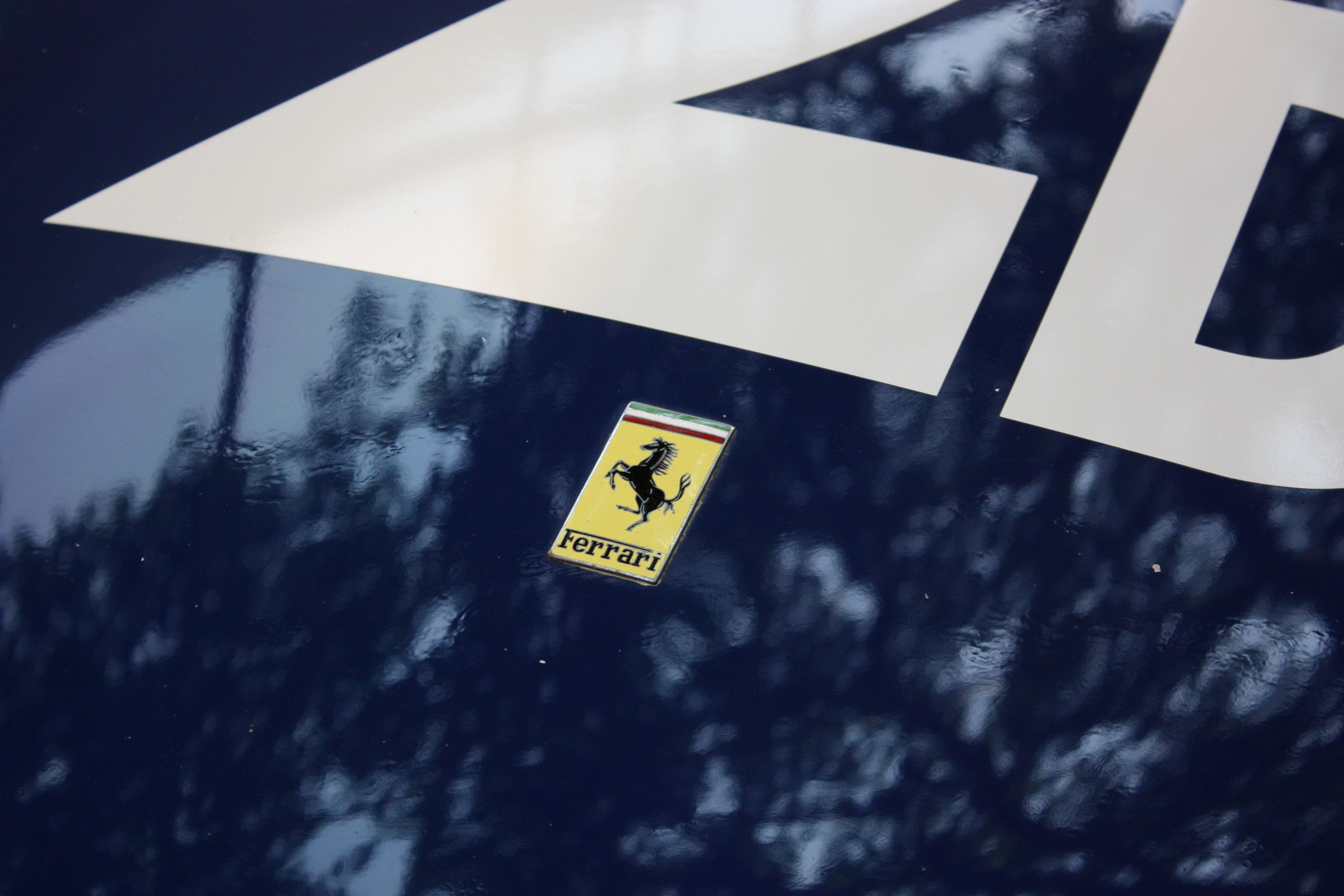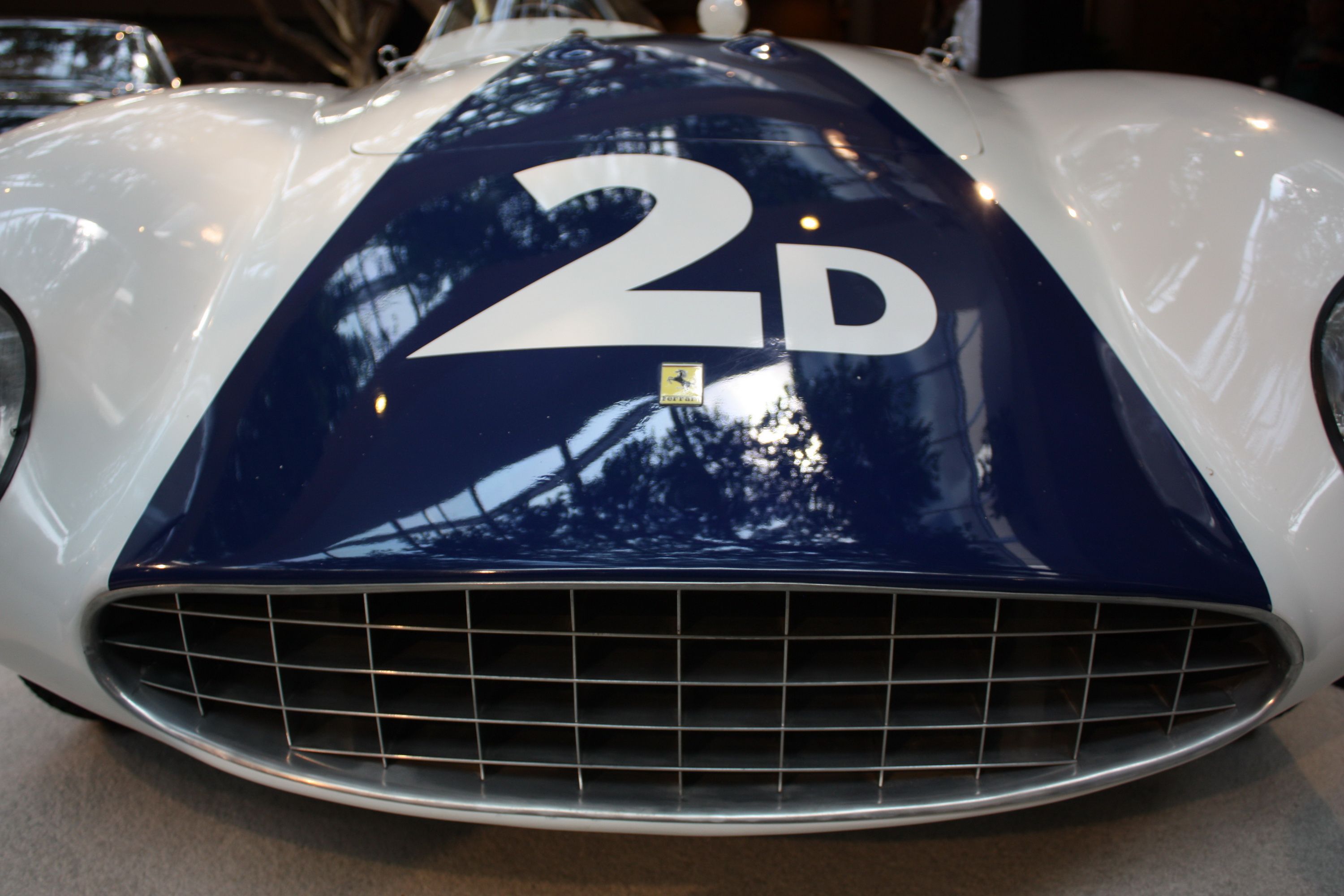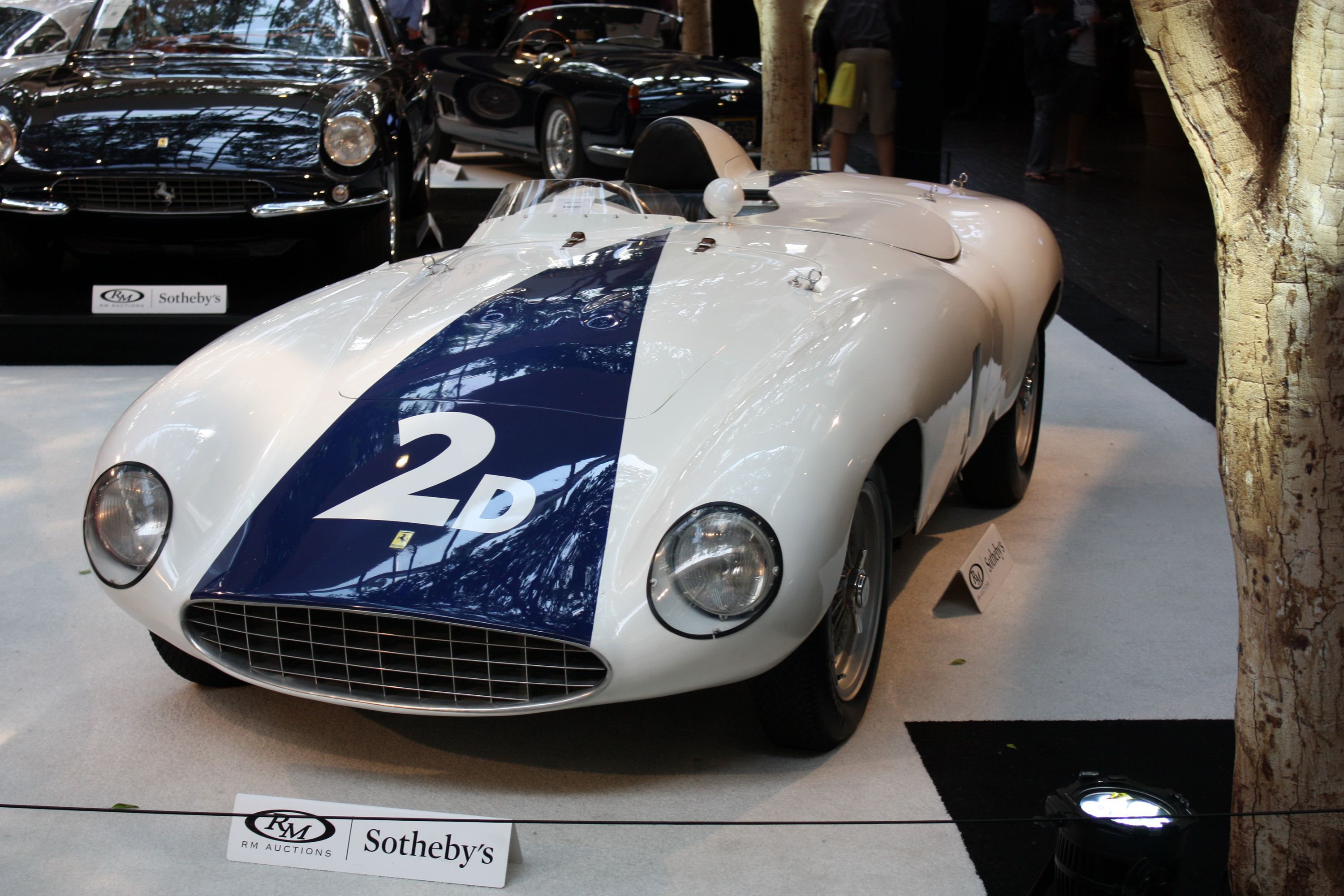Ferrari built the Monza between 1953 and 1957, producing one of the world’s top collector cars in the process. In that timespan, this open-top sports racer collected a wide variety of trophies and accolades, offering up impressive capabilities for any driver willing to tame it. The 750 variant of the Monza dropped in 1954, making its competition debut at the Italian racetrack from which it draws its name. The model is also important because it marks the transitional period from the Colombo V-12 to the Lampredi four-cylinder engine, the latter of which would play an integral role in Ferrari’s competition history.
However, some 750 Monzas are considered more desirable than others, and this particular vehicle you see pictured here is one such example. It was recently put on the block at the RM Sotheby’s auction in Monterey, trading hands for well over $5 million.
Why so expensive? For starters, this car came from the personal collection of the great American race car driver Jim Hall, who had the car in his possession for 60 years before it was auctioned off. This example also won a slew of races at the hands of legends like Carroll Shelby and Phil Hill, and it arrived in Monterey in a pristine, unmodified condition.
Long story short, this is quite likely the most desirable Ferrari 750 Monza in the world. Read on for all the details.
Continue reading to learn more about the 1955 Ferrari 750 Monza Spider.
1955 Ferrari 750 Monza Spider
- Make: Array
- Model: 1955 Ferrari 750 Monza Spider
- [do not use] Vehicle Model: Array
History And Background
By the mid-‘50s, sports car racing had swept across America, enthralling the nation with promises of adrenaline-fueled four-wheel glory. The Ferrari 750 Monza was one of the participants in the craze, but this particular example stands out as a truly exceptional racing car.
“So often, these race cars were driven hard, put away wet, damaged in accidents, and often modified for the sake of performance, as their drivers sought to extract just one more race behind the wheel,” says RM Sotheby’s. “It was extremely rare for a racing car to enter the crucible of motorsport and leave unscathed and unmolested.”
This car is one of those rare exceptions, a quality compounded by its ownership history. Prior to selling in Monterey, this 750 Monza was owned by Jim Hall, the former Formula One driver and part owner of Chaparral Cars. Hall is also known for his participation in the Can-Am and Trans-Am racing series, and as an early proponent of aerodynamics for use on racing cars.
Hall owned this car for six decades, and throughout its lifetime, it was never modified or stuffed into a wall.
The car’s story begins with its first owner, Allen Guiberson, a manufacturer of drilling and refinery equipment from Dallas, Texas. Guiberson bought the car new, then proceeded to entrust it in the hands of some of America’s all-time greatest racing drivers.
This particular example saw its competition debut at the 12 Hours of Sebring in 1955, where Phil Hill and Carroll Shelby were tasked with piloting it. The Monza ended up crossing the finish line first, ahead of the Jaguar D-Type of Phil Waters and Mike Hawthorn, but later review of the results awarded the first-place finish to the Jag, which had apparently taken victory over the Ferrari by just 25 seconds.
Afterwards, Phil Hill secured a first-place finish and the Del Monte trophy at the Pebble Beach Road races, going on to a second-place finish in Palm Springs.
Following the Palm Springs podium, Guiberson sold the car to Jim Hall and his brother, Dick, and subsequently, the car would remain in the Hall’s stead for sixty years.
However, the Ferrari wasn’t done raking in the wins. Carroll Shelby once again took the reins in 1956, securing back-to-back wins in Pebble Beach with a repeat victory. Shelby and the Ferrari then went to Dodge City, Kansas, followed by Eagle Mountain, Texas, where he once again managed to secure two first-place finishes.
Following the race in Dodge City, the car was sent to Maranello for service, as the engine had gulped some debris and needed attention. During the car’s service, the Maranello craftsmen installed a door on the left-hand side of the chassis to help it pass FIA Index C regulations. It was at this time the car also got a proper windshield, and it was repainted in red.
Jim Hall finally took the wheel for a race at Fort Sumner, New Mexico. The event was reportedly no cake walk for Hill, who was racing the Ferrari for the very first time in New Mexico, but he eventually managed to secure yet another first-place finish over the talented SCCA-superstar Jack McAfee and his Porsche 550 Spyder.
Before the start of the 1957 season, Phil Hill purchased the car outright from his brother, then wheeled the car to a series of podiums in sports car races, several of which took place in his home state of Texas.
After amassing an impressive number of wins, the car was put into storage in Texas for roughly 40 years. During this time, Jim Hall would intermittently start the car and run it for a few laps around his test track, just to make sure it was still working properly.
In the mid-‘90s, the car was entrusted to Troy Rogers (one-time chief mechanic at the Chaparral racing team) for restoration. Rogers replaced the bell housing and starter, but the rest of the car was retained in its original condition. It was at this time that the car was repainted in its original blue-on-white paint scheme.
While its racing days may be behind it, this Ferrari still enjoys a fair bit of exposure. It went to Monterey in 1997 for the Historics event at Laguna Seca as part of a tribute to Carroll Shelby, then arrived in Pebble Beach in 2005 for the Concours d’Elegance as part of a tribute to Phil Hill and Stirling Moss. It was also put on display at the Los Angeles Petersen Automotive Museum in 2011.
Exterior
The 750 Monza uses coachwork hammered by hand at Scaglietti. The look is gorgeous, featuring all the elegance and curviness you’d expect from an old school Prancing Horse icon. It’s low-slung and wide, but also surprisingly small once you get up close to it. The look integrates the headlights into the curvaceous front fenders, leading down into an oval front grille – both features seen later on the highly admired Ferrari 250 GTO.
The profile is plain and sleek, the lines leading from the nose in a straightforward, streamlined fashion, with the only embellishments being rectangular cutouts behind the front fenders. The rear end is equally simple, showing two oval cutouts that are barely noticeable on the elliptical tail.
Up top, you’ll find a raised, fin-like section for the headrest, plus a single rear-facing mirror to the left of the driver, which is used to watch all the cars that can’t keep up. Wire wheels are located in the corners.
One of the defining features on this particular example is the large dark blue triangle that stretches from the front nose back into the cabin, a design that’s repeated in the tail. The race numbers “2D” are emblazoned on top.
Interior
Given the car’s role as a competition vehicle, there’s not much to say about the interior. There’s a short windshield to keep most of the bugs out of the driver’s teeth, plus a large, three-spoke wood-trimmed steering wheel. The gauges are surrounded by chrome, and the seat, like the rest of the cockpit, is pure function.
Drivetrain
The 750 Monza uses a front-engine, RWD layout. Under the nose lies a 3.0-liter (2,999 cc) inline four-cylinder engine, with double overhead cams and two Weber 58 DCO/A3 carburetors. Output when new was rated at roughly 260 horsepower.
While not as well known as the V-12, the Monza’s Lamperdi four-cylinder was vital to the marque’s motorsports efforts, with variations powering a slew of competition vehicles, including Ferrari’s Formula Two cars, sports cars, Le Mans cars, and Formula One cars.
The four-cylinder in this 750 Monza mates to a five-speed manual transaxle.
Chassis And Handling
Under the pretty bodywork, you’ll find a tubular steel frame. Making it handle is an independent suspension set-up in front that utilizes coil springs, while in back, there’s a non-independent De Dion tube rear axle with semi-elliptical leaf springs and parallel trailing arms. Providing the stops are oversized drum brakes at each of the four corners.
This set-up was considered quite sophisticated for its day, but one of the 750 Monza’s greatest strengths was its low weight – tipping the scales at just 1,675 pounds, this little track terror could seriously move.
Prices
In total, roughly 30 examples of the car were built, and auction prices tend to vary widely depending on condition and history. Back in 2013, RM Sotheby’s sold an exquisite 1955 example in Monterey for $4,070,000. However, thanks to its previous ownership and immaculate condition, the example pictured here (chassis 0510 M) sold in Monterey this past August for $5,225,000, even as the collector car market continues to cool from the insanity of 2013.
Further boosting the sale was the inclusion of letters from Carroll Shelby and Phil Hill that detail their experiences with the car.
Competition
Jaguar D-Type
The D-Type is one of Jaguar’s most famous racing cars. Produced between 1954 and 1957, this roadster offered a monocoque chassis made from aluminum – a true innovation for the time. The suspension and disc brakes were the same as the preceding C-Type, but the engine was revised with new heads and valves. Flat out, the D-Type could hit 173 mph down the Mulsanne Straight.
Read more about the Jaguar D-Type here.
Porsche 550 Spyder
Porsche made the 550 between 1953 and 1956. It uses a mid-mounted, all-aluminum four-cylinder engine producing roughly 108 horsepower. The little racer ran in a variety of different series, and famously, German driver Hans Herrmann managed to take one under a closed railroad crossing during the Mille Miglia road race in 1954.
Learn more about the Porsche 550 Spyder here.
Conclusion
In a recent interview with RM Sotheby’s, Jim Hall remembered what it was like to drive the 750 Monza, saying, “I remember driving it for the first time and was amazed by it. It had lots of torque and you had to shift through the gears quickly, but it had lots of go. The brakes were fantastic, even though they were drums. I thought it was a fabulous race car.”
This amazing Prancing Horse remains an important piece of Ferrari’s history, and although not all of them were driven by a selection of America’s most famous racing drivers, their status as high-end collector cars remains rock solid.

